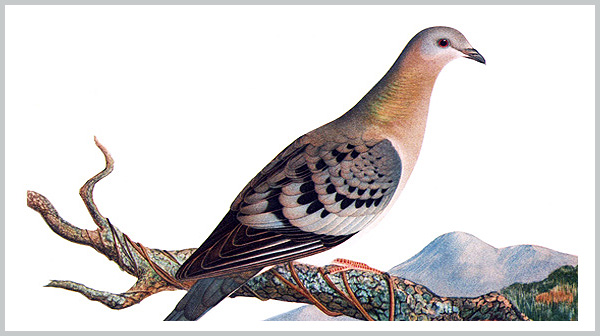
Passenger Pigeon
Name: Passenger Pigeon (Ectopistes migratorius)
Conservation Status: Extinct
How could the passenger pigeon be extinct when it was the most abundant bird species on Earth no so long ago? It is almost impossible to imagine that the passenger pigeons’ population, which in the early 1800’s contained more individuals than all other North American birds combined, was reduced to just one individual, Martha, who died in captivity at the Cincinnati Zoo in 1914.
Before their decimation, a single flock of passenger pigeons could have 2 billion birds or more, and there were multiple flocks of birds in the United States.
When John J. Audubon observed a migrating flock over Kentucky in 1813, he reported that the sky was “black with birds” for three days.
The nesting colonies of the passenger pigeon in northeastern deciduous forests could be 20 miles across, with so many birds per tree that the branches broke from their weight. Yet, there is not a single passenger pigeon left for us to observe today.
The passenger pigeon was driven to extinction by uncontrolled commercial hunting for their meat, which was desired by Euroamerican settlers.
The passenger pigeons‘ migration and nesting behavior made them easy to hunt in large numbers. They were netted, shot and smoked out of trees with sulfur torches. Special firearms, including a forerunner of the machine gun, were used to harvest these birds in quantity.
The growth of commercial enterprises was facilitated by the railroads, which made it possible (and profitable) to transport the meat quickly to urban centers.
By 1850, several thousand people were employed in the passenger pigeon industry. In New York, one operation processed 18,000 pigeons each day in 1855. In one year in Michigan alone, a billion birds were harvested.
Not surprisingly, the population collapsed. Although several thousand birds survived in 1880, it was no longer profitable to hunt them since they were widely dispersed across the continent. Ironically, this scattered distribution, which saved a large core population for the post-commercial era, may also have contributed to the passenger pigeon’s ultimate demise by interfering with breeding abilities.
The reasons that the passenger pigeon was unable to recover from the period of overexploitation are not fully known. Some species have been able to recover from a low number of individuals, but the passenger pigeon continued to decline and was extinct in the wild by 1900. Captive breeding efforts were not successful and the last individual died in 1914.
One theory explaining the passenger pigeon’s inability to recover is that their breeding patterns required a community of numerous individuals to stimulate the necessary cycles or behaviors. Previously, the large colonies had provided the necessary conditions, but the scattered populations after 1880 may not have had a large enough concentration in any one area to stimulate breeding behaviors.
The passenger pigeon’s inability to recover may also have been influenced by the scattered distribution of remaining individuals by making it more difficult to find suitable mates. Without their swarming flocks, the passenger pigeons also may have had trouble competing with other birds for nest sites, and nest sites may have been fewer as the deciduous forests were cut down.
Whatever the reason, it is clear that the passenger pigeon did not have a viable population when commercial hunting ceased. Although commercial hunting did not directly kill the last passenger pigeon, it sent the species into an extinction vortex from which it could not recover.
Questions for Thought:
Passenger pigeons were one of the most important food resources for numerous carnivores, such as foxes, lynx, raccoons, marten and mink, and for several raptors, such as falcons and hawks. What repercussions would the passenger pigeon’s extinction have for these species? What other effects might have occurred in the ecosystem?
One of the things that died with the passenger pigeon was the phenomenon of its migration, the endless sea of birds blackening the sky. Even if the passenger pigeon had survived as a species, this impressive phenomenon could not have continued without the huge number of birds that existed in the early 1800s.
What other mass migrations no longer occur or are in danger of disappearing because the animals that migrate are threatened or endangered?
Many people see the rock dove, a relative of the passenger pigeon, every day in American cities. Some would say there are far too many of them, especially when looking for a clean park bench to sit on. Can you imagine the rock dove becoming extinct? Why or why not?
If railroads had never existed, do you think the passenger pigeon might have survived? What is the difference between commercial hunting and other kinds of hunting? Since all of the passenger pigeon companies had a stake in the passenger pigeon’s continuing survival, why do you think they failed to work together to conserve the species?
Related Classroom Activities
[CS2-8,C3-1,C3-2, General]